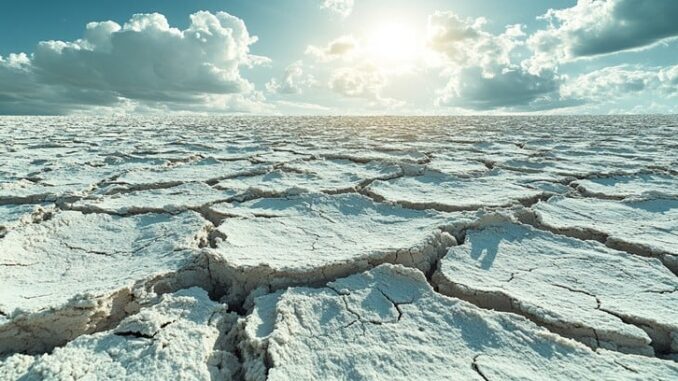
A snow drought occurs when snowfall is significantly below normal levels. According to the American Meteorological Society’s Glossary of Meteorology, there are two types of snow droughts: dry snow drought and warm snow drought. A dry snow drought happens when temperatures are colder than usual, limiting the amount of moisture the air can hold. As a result, snowfall is reduced or even absent. In contrast, a warm snow drought occurs when higher-than-normal temperatures lead to precipitation falling as rain instead of snow or cause existing snowpack to melt too soon.
As of 2023, it stands as the hottest year on record. The unusually high surface temperatures of the Pacific Ocean have altered atmospheric conditions and precipitation patterns, intensifying the El Niño climate pattern. During El Niño, warmer ocean waters shift the Pacific jet stream south of its neutral position, leading to increased rainfall across the Southern U.S. In contrast, the Northern U.S. experiences warmer temperatures and drier conditions than usual.
Snowfall across the Midwest has been well below average, with parts of Upper Michigan and Minnesota experiencing deficits exceeding 20 inches. In early December 2023, temperatures in cities like Minneapolis neared 50 degrees Fahrenheit—highly unusual for that time of year. Similar trends have been observed in the Pacific Northwest, where snowfall has remained scarce despite winter’s arrival. Meanwhile, cities in the Northeast, such as Philadelphia and New York, have gone nearly 700 days without receiving an inch of snowfall in a single day, marking a significant deviation from historical winter patterns. These anomalies reflect broader climate shifts that are reshaping seasonal weather patterns across North America.
Snow droughts can severely disrupt ecosystems, affecting both flora and fauna. Without an insulating snow layer, plant roots are exposed to cold air, jeopardizing their health and survival. This can lead to frost damage, reduced nutrient uptake, and stunted growth in many plant species, including those critical to agricultural industries and forest ecosystems. Animals adapted to snowy conditions, such as lynx and jackrabbits, struggle to hunt prey or evade predators when snow is scarce. Snow serves as camouflage for both predators and prey, and its absence can upend delicate ecological balances, leading to population declines and shifts in species distribution.
Additionally, the absence of snow cover alters temperature dynamics. Snow acts as a natural reflector of sunlight, helping regulate local temperatures. When snow is limited, darker surfaces like soil and vegetation absorb more sunlight, accelerating warming. This phenomenon, known as the albedo effect, amplifies temperature increases and exacerbates regional climate change. Warmer conditions can also lead to more frequent freeze-thaw cycles, which damage infrastructure such as roads, bridges, and pipelines, increasing maintenance costs and safety hazards for communities.
The consequences of snow droughts extend well beyond winter. Snowpack functions as a natural water reservoir, gradually releasing meltwater to sustain rivers, lakes, and groundwater systems. When snowfall is insufficient, the reduced snowmelt leads to water shortages in the following spring and summer months. Lower soil moisture can hinder plant and crop growth, reducing agricultural yields and threatening food security. Drier conditions also heighten wildfire risk, as parched vegetation becomes highly flammable. In recent years, regions experiencing snow droughts have seen earlier and more intense wildfire seasons, with devastating consequences for both ecosystems and human settlements.
Weakened stream flows degrade water quality, as lower volumes of water concentrate pollutants and disrupt aquatic ecosystems. Many fish species, including salmon and trout, rely on cold, steady stream flows for migration and reproduction. When water levels drop and temperatures rise, these species face increased stress, leading to declines in population numbers and disruptions to commercial and recreational fishing industries. Additionally, reduced snowmelt diminishes the supply of drinking and irrigation water, placing further strain on communities that depend on seasonal runoff for their water needs.
As global temperatures continue to rise, snow droughts are expected to become more frequent and severe. Their impacts will not only be felt in remote mountain ranges or northern forests but will also affect agriculture, water security, and urban infrastructure. The repercussions of these changes are unmistakably destructive to both human activity and wildlife, underscoring the urgent need for adaptive strategies, improved water management policies, and climate mitigation efforts to address the growing risks associated with diminishing snowfall.
Matter referenced from:
Grace Wu, 28.12.2023. Snow Drought Adds Insult to Injury for Ecosystems. https://emagazine.com/snow-drought-adds-insult-to-injury-for-ecosystems/
By: Dr. Bhawana Asnani.
Happy to see Reviews, Additions, Suggestions and Comments, further.
